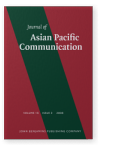Vol. 18:2 (2008) ► pp.268–279
Pre-imperial Chinese
Its hurdles towards becoming a world language
Along with the rapid economic development of China, the Chinese language is becoming a popular target language of learning in the world. A large number of learners try hard to learn Chinese. It is even believed that this situation is not a fad; instead it will continue and will make Chinese a world language. This paper is a conceptual and theoretical refutation of the possibility of such a happening. An analysis is made with occasional comparison to English from the perspectives of sociolinguistics and specific limitations of the Chinese language. It is argued that the concept of world language is related to the concept of language dominance. Although economic status and population of speakers may facilitate the promotion of a language, they are far from enough to make it possible. A language spreads on several more conditions. Among them are the broad acceptance of the traditional culture that a language represents, extensively scattered speech communities, a multiplicity of audio-visual publications of wide circulation, and more importantly, ease of learning and use. Evidence shows that none of these conditions currently exists for Chinese. In particular, the complexity and difficulty of the writing system handicap its spread.
Cited by
Cited by 5 other publications
This list is based on CrossRef data as of 4 july 2024. Please note that it may not be complete. Sources presented here have been supplied by the respective publishers. Any errors therein should be reported to them.
